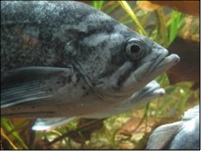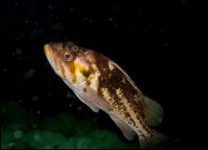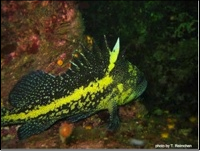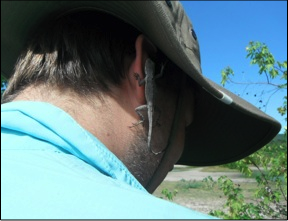Adaptive radiations occur when a lineage rapidly splits into many new and ecologically divergent species, and are responsible for a substantial component of Earth's biodiversity. During Travis' Ph.D. at the University of British Columbia he worked extensively on the adaptive radiation of rockfish (Sebastes spp.) in the northeast Pacific. This is among the most speciose marine fish genera (>100 species worldwide), which includes considerable diversity in morphology, colour and life history (some species live well over 100 years).
Travis' thesis work investigated diversification among rockfish species in trophic position (their ‘vertical’ position in the food web), and in depth habitat (species occur from shallow subtidal habitats to >1000m). Trait-based analyses of community assembly found tentative support for trophic niche differentiation as well as habitat filtering associated with water depth (pdf). Travis later developed a macroevolutionary parameter (Ψ) to investigate whether divergence in trophic position or depth was associated with speciation events (i.e. nodes in the phylogeny). Depth habitat and associated traits showed a strong signal of speciational evolution (pdf), supporting other lines of evidence that the depth gradient plays a key role in rockfish speciation. Later studies have investigated the characteristics of evolutionarily distinctive rockfish species (pdf) and the diversification of geometric body shape in Sebastes (pdf).
Travis' postdoc in the Losos Lab at Harvard applied comparative methods to the famous adaptive radiations of Anolis lizards in the Caribbean. His development of the method surface with Luke Mahler allowed us to re-evaluate the extent of ecomorphological convergence among island lizard faunas, and confirm that convergence is exceptional and can be explained by peak shifts on an adaptive landscape (pdf). Using similar methods, Travis later found that Sebastes rockfishes also show signs of morphological convergence, but that most convergence was within rather than between regions of the ocean (pdf).
While comparative methods and macroevolution are not a primary areas of our current research, we are collaborating to investigate climatic niche diversification in New Zealand's endemic radiations of geckos and skinks.
The ecological drivers of diversity and disparity in adaptive radiations



Blue Rockfish (S. mystinus)
Copper Rockfish (S. caurinus)
China Rockfish (S. nebulosus)

